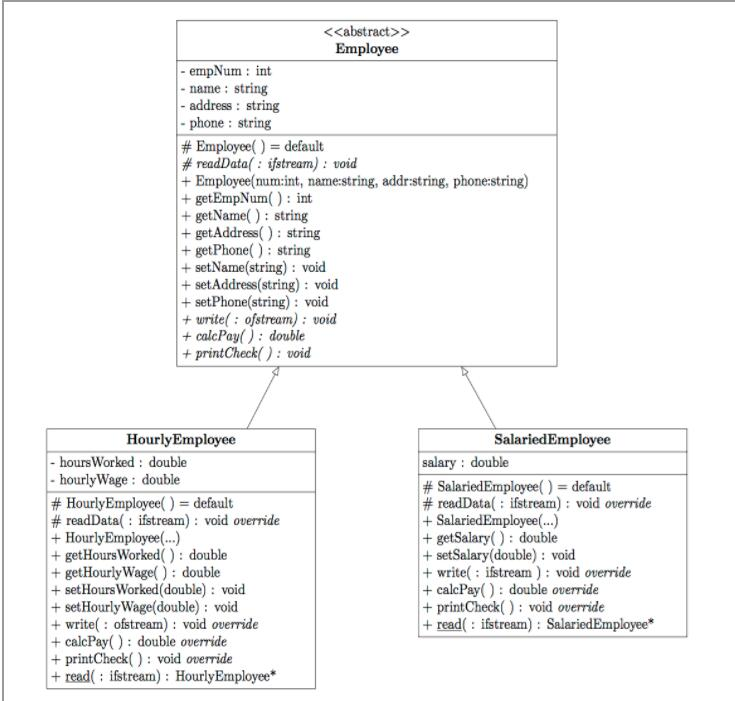Question
C++ UML diagram The key functions work as follows: read This static member function creates an empty, derived employee object and then calls readData to
C++
UML diagram

The key functions work as follows:
read
This static member function creates an empty, derived employee object and then calls readData to initialize it. It returns a pointer to a new object, if data was read correctly, or nullptr if there was an input error. For example, HourlyEmployee::read creates a new, empty HourlyEmployee object on the heap, emp, say. and then calls emp->readData. HourlyEmployee::readData calls Employee::readData to read in the common employee fields from a file, and then reads in the hourly wage and hours worked. The pointer to the initialized object (or nullptr) is then returned.
readData
As explained above, this function first calls the base class implementation of readData, and then reads data form the file for its type of object (HourlyEmployee or SalariedEmployee).
write
This function works similarly to readData: it first calls Employee::write to write out the common data to the file, then writes out the specific derived class data.
printCheck
This function first calls Employee::printCheck to print the common check header, then prints the rest of the check according to the type of the object. See the sample output below to see how SalariedEmployee checks should look.
calcPay
Hourly Employees: An hourly employee's gross pay is calculated by multiplying the hours worked by their hourly wage. Be sure to give time-and-a-half for overtime (anything over 40 hours). To compute the net pay, deduct 20% of the gross for Federal income tax, and 7.5% of the gross for state income tax.
Salaried Employees: A salaried employee's gross pay is just their weekly salary value. To compute the net pay for a salaried employee, deduct 20% of the gross for Federal income tax, 7.5% of the gross for state income tax, and 5.24% for benefits.
Objectives:
Continue gaining experience with object-oriented design
Learn to create a class hierarchy that is enabled for polymorphism
Learn to use polymorphism in a program.
The Driver
Your driver will provide the same set of options as in the previous project. However, your driver code should be somewhat simpler because you will now create a vector of Employee pointers, and store the pointers to your objects in this vector. Add heap pointers to the following employees to your vector:
HourlyEmployee(1, "H. Potter", "Privet Drive", "201-9090", 40, 12.00); SalariedEmployee(2, "A. Dumbledore", "Hogwarts", "803-1230", 1200); HourlyEmployee(3, "R. Weasley", "The Burrow", "892-2000", 40, 10.00); SalariedEmployee(4, "R. Hagrid", "Hogwarts", "910-8765", 1000);
You can then use a simple for loop to save each object's data to the file. Here is a sample execution of Option 1:
This program has two options:
1 - Create a data file, or
2 - Read data from a file and print paychecks.
Please enter (1) to create a file or (2) to print checks:1
Please enter a file name: employee.txt
Data file created ... you can now run option 2.
The contents of the file employee.txt should be:
1
H. Potter
Privet Drive
201-9090
40
12
2
A. Dumbledore
Hogwarts
803-1230
1200
3
R. Weasley
The Burrow
892-2000
40
10
4
R. Hagrid
Hogwarts
910-8765
1000
When you run option 2, your program should create a new vector of Employee pointers. Make four calls to either HourlyEmployee::read or SalariedEmployee::read, according to the same order that you wrote the objects in part 1. Add the pointers returned by read to your vector. Then loop through the vector printing out the checks. Here is an execution of Option 2:
This program has two options:
1 - Create a data file, or
2 - Read data from a file and print paychecks.
Please enter (1) to create a file or (2) to print checks:2
Please enter a file name: employee.txt
--------------------FluffShuffle Electronics-------------------------------
Pay to the order of H. Potter....................................$348.00
United Bank of Eastern Orem
Hours worked: 40.00
HourlyWage: 12.00
--------------------FluffShuffle Electronics-------------------------------
Pay to the order of A. Dumbledore....................................$807.12
United Bank of Eastern Orem
Salary: 1200.00
--------------------FluffShuffle Electronics-------------------------------
Pay to the order of R. Weasley....................................$290.00
United Bank of Eastern Orem
Hours worked: 40.00
HourlyWage: 10.00
--------------------FluffShuffle Electronics-------------------------------
Pay to the order of R. Hagrid....................................$672.60
United Bank of Eastern Orem
Salary: 1000.00
From the end user's point of view, your program will work just as it did before.
abstract>> Employee empNum int name: string - address: string phone string # Employee( ) = default # readData( : ifstream) : void + Employee(numint, name:string, addr.string, phone:string + getEmpNum(): int + getName(): string + getAddress() string +getPhone): string + setName(string): void + setAddress(string): void + setPhone(string): voicd + writel: ofstream): void + calcPay(): double + printCheck(): void Hourly Employee SalariedEmployee -hoursWorked: double - hourly Wage: double # HourlyEmployee( ) = default # readData( : ifstream ) : void override + HourlyEmployee(. + getHoursWorked(): double + getHourly Wage(): double + setHoursWorked(double void + setHourly Wage(double) void + write ofstream): void override + calcPay(): double override + printCheck): void override + read( ifstream): HourlyEmployee salary double # SalariedEmployee( ) = default # readDataf; istream) : void override + SalariedEmployee(.) + getSalary(): double + setSalary(double): void + write(: ifstream): void override + calcPay): double override +printCheck() void override + read(: ifstream SalariedEmployeeStep by Step Solution
There are 3 Steps involved in it
Step: 1

Get Instant Access to Expert-Tailored Solutions
See step-by-step solutions with expert insights and AI powered tools for academic success
Step: 2

Step: 3

Ace Your Homework with AI
Get the answers you need in no time with our AI-driven, step-by-step assistance
Get Started


